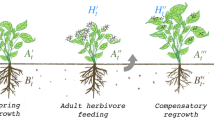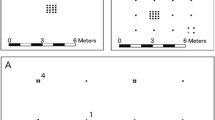Abstract
Insect attack can have major consequences for plant population dynamics. We used individually based simulation models to ask how insect oviposition behaviour influences persistence and potential stability of an herbivore–plant system. We emphasised effects on system dynamics of herbivore travel costs and of two kinds of behaviour that might evolve to mitigate travel costs: insect clutch size behaviour (whether eggs are laid singly or in groups) and female aggregation behaviour (whether females prefer or avoid plants already bearing eggs). Travel costs that increase as plant populations drop lead to inverse density dependence of plant reproduction under herbivore attack. Female clutch size and aggregation behaviours also strongly affect system dynamics. When females lay eggs in large clutches or aggregate their clutches, herbivore damage varies strongly among plants, providing probabilistic refuges that permit plant reproduction and persistence. However, the population dynamics depend strongly on whether insect behaviour is fixed or responds adaptively to plant population size: when (and only when) females increase clutch size or aggregation as plants become rare, refuges from herbivory weaken at high plant density, creating inverse density dependence in plant reproduction. Both herbivore travel costs themselves, and also insect behaviour that might evolve in response to travel costs, can thus create plant density dependence—a basic requirement for regulation of plant populations by their insect herbivores.





Similar content being viewed by others
References
Anderson P, Löfqvist J (1996) Asymmetric oviposition behaviour and the influence of larval competition in the two pyralid moths, Ephestia kuehniella and Plodia interpunctella. Oikos 76:47–56
Anderson RM, May RM (1978) Regulation and stability of host–parasite population interactions. I. Regulatory processes. J Anim Ecol 47:219–249
Atkinson WD, Shorrocks B (1981) Competition on a divided and ephemeral resource: a simulation study. J Anim Ecol 50:461–471
Bach CE (1994) Effects of a specialist herbivore (Altica subplicata) on Salix cordata and sand dune succession. Ecol Monogr 64:423–445
Benson WW, Brown KS Jr, Gilbert LE (1975) Coevolution of plants and herbivores: passion flower butterflies. Evolution 29:659–680
Büning J (1994) The insect ovary: ultrastructure, previtellogenic growth, and evolution. Chapman and Hall, London, UK
Caughley G, Lawton JH (1981) Plant–herbivore systems. In: May RM (ed) Theoretical ecology: principles and applications. Blackwell Scientific Publications, Oxford, UK, pp 132–166
Colautti RI, Bailey SA, van Overdijk CDA, Amundsen K, MacIsaac HJ (2006) Characterised and projected costs of nonindigenous species in Canada. Biological Invasions 8:45–59
Courtney SP (1986) The ecology of pierid butterflies: dynamics and interactions. Adv Ecol Res 15:51–131
Crawley MJ (1983) Herbivory: the dynamics of animal–plant interactions. University of California, Berkeley, CA, p 437
Cronin JT, Strong DR (1999) Dispersal-dependent oviposition and the aggregation of parasitism. Am Nat 154:23–36
Dempster JP (1997) The role of larval food resources and adult movement in the population dynamics of the orange-tip butterfly (Anthocharis cardamines). Oecologia 111:549–556
DeWalt SJ, Denslow JS, Ickes K (2004) Natural-enemy release facilitates habitat expansion of the invasive tropical shrub Clidemia. Ecology 85:471–483
Dhileepan K (2001) The effectiveness of introduced biocontrol insects on the weed Parthenium hysterophorus (Asteraceae) in Australia. Bull Entomol Res 91:167–176
Diaz-Fleischer F, Aluja M (2003) Influence of conspecific presence, experience, and host quality on oviposition behaviour and clutch size determination in Anastrepha ludens (Diptera: Tephritidae). J Insect Behav 16:537–554
Eber S (2004) Bottom-up density regulation in the holly leaf-miner Phytomyza ilicis. J Anim Ecol 73:948–958
Fagan WF, Bishop JG (2000) Trophic interactions during primary succession: herbivores slow a plant reinvasion at Mount St. Helens. Am Nat 155:238–251
Fornoni J, Núñez-Farfán J, Valverde PL (2003) Evolutionary ecology of tolerance to herbivory: advances and perspectives. Comments Theor Biol 8:643–663
Green RF (1986) Does aggregation prevent competitive exclusion? A response to Atkinson and Shorrocks. Am Nat 128:301–304
Hairston NG, Smith FE, Slobodkin LB (1960) Community structure, population control, and competition. Am Nat 94:421–425
Halpern SL, Underwood N (2006) Approaches for testing herbivore effects on plant population dynamics. J Appl Ecol 43:922–929
Harmon JP, Hladilek EE, Hinton JL, Stodola TJ, Andow DA (2004) Herbivore response to vegetational diversity: spatial interaction of resources and natural enemies. Popul Ecol 45:75–81
Harris P (1986) Biological control of weeds. In: Franz JM (ed) Biological plant and health protection: biological control of plant pests and of vectors of human and animal diseases. Gustav Fischer, Stuttgart, pp 123–138
Hassell MP (1980) Foraging strategies, population models and biological control: a case study. J Anim Ecol 49:603–628
Hassell MP, Comins HN (1976) Discrete time models for two-species competition. Theor Popul Biol 9:202–221
Hassell MP, May RM (1988) Spatial heterogeneity and the dynamics of host–parasitoid systems. Ann Zool Fenn 25:55–61
Heard SB (1998) Resource patch density and larval aggregation in mushroom-breeding flies. Oikos 81:187–195
Heard SB, Remer LC (1997) Clutch size behaviour and coexistence in ephemeral-patch competition models. Am Nat 150:744–770
Heard SB, Buchanan CK (1998) Larval performance and association within and between species of hackberry nipple gall insects, Pachypsylla spp. (Homoptera: Psyllidae). Am Midl Nat 140:351–357
Hendrix SD (1988) Herbivory and its impact on plant reproduction. In: Doust JL (ed) Plant reproductive ecology: patterns and strategies. Oxford University Press, New York, NY, pp 246–263
Huffaker CB (1958) Experimental studies on predation: dispersion factors and predator–prey oscillations. Hilgardia 27:343–383
Inouye BD, Johnson DM (2005) Larval aggregation affects feeding rate in Chlosyne poecile (Lepidoptera: Nymphalidae). Fla Entomol 88:247–252
Ives AR (1991) Aggregation and coexistence in a carrion fly community. Ecol Monogr 61:75–94
Ives AR (1992) Density-dependent and density-independent parasitoid aggregation in model host–parasitoid systems. Am Nat 140:912–937
Johannesen J, Loeschcke V (1996) Distribution, abundance, and oviposition patterns of four coexisting Chiastocheta species (Diptera: Anthomyiidae). J Anim Ecol 65:567–576
Louda SM (2001) Discovering an effect of insect floral herbivory on plant population density and distribution in a “green world”. Bull Ecol Soc Am 82:229–231
Mack RN, Simberloff D, Lonsdale WM, Evans H, Clout M, Bazzaz FA (2000) Biotic invasions: causes, epidemiology, global consequences, and control. Ecol Appl 10:689–710
Maron JL, Crone EE (2006) Herbivory: effects on plant abundance, distribution and population growth. Proc R Soc Lond B 273:2575–2584
Maron JL, Combs JK, Louda SM (2002) Convergent demographic effects of insect attack on related thistles in coastal vs. continental dunes. Ecology 83:3382–3392
McConnachie AJ, Hill MP, Byrne MJ, de Wit MP (2003) Economic evaluation of the successful biological control of Azolla filiculoides in South Africa. Biol Control 28:25–32
Microsoft (1988) Microsoft QuickBASIC, version 4.50. Microsoft Corp., Redmond, WA
Monro J (1967) The exploitation and conservation of resources by populations of insects. J Anim Ecol 36:531–547
Moran VC, Hoffmann JH, Zimmermann HG (2005) Biological control of invasive alien plants in South Africa: necessity, circumspection, and success. Front Ecol Environ 3:77–83
Morris WF, Wiser SD, Klepetka B (1992) Causes and consequences of spatial aggregation in the phytophagous beetle Altrica tombacina. J Anim Ecol 61:49–58
Myers JH (1976) Distribution and dispersal in populations capable of resource depletion. Oecologia 23:255–269
Myers JH, Harris P (1980) Distribution of Urophora galls in flower heads of diffuse and spotted knapweed in British Columbia. J Appl Ecol 17:359–367
Myers JH, Monro J, Murray N (1981) Egg clumping, host plant selection and population regulation in Cactoblastis cactorum (Lepidoptera). Oecologia 51:7–13
Raghu S, Dhileepan K (2005) The value of simulating herbivory in selecting effective weed biological control agents. Biol Control 34:265–273
Reed RD (2003) Gregarious oviposition and clutch size adjustment by a Heliconius butterfly. Biotropica 35:555–559
Remer LC, Heard SB (1998) Local movement and edge effects on competition and coexistence in ephemeral-patch models. Am Nat 152:896–904
Rohani P, Godfray HCJ, Hassell MP (1994) Aggregation and the dynamics of host–parasitoid systems: a discrete-generation model with within-generation redistribution. Am Nat 144:491–509
Rohlfs M, Hoffmeister TS (2004) Spatial aggregation across ephemeral resource patches in insect communities: an adaptive response to natural enemies? Oecologia 140:654–661
Roitberg BD, Prokopy RJ (1983) Host deprivation influence on response of Rhagoletis pomonella to its oviposition deterring pheromone. Physiol Entomol 8:69–72
Rose KE, Louda SM, Rees M (2005) Demographic and evolutionary impacts of native and invasive insect herbivores on Cirsium. Ecol 86:453–465
Sevenster JG, van Alphen JJM (1996) Aggregation and coexistence. 2. A neotropical Drosophila community. J Anim Ecol 65:308–324
Shea K, Smyth M, Sheppard A, Morton R, Chalimbaud J (2000) Effect of patch size and plant density of Paterson’s curse (Echium plantagineum) on the oviposition of a specialist weevil, Morgulones larvatus. Oecologia 124:615–621
Simberloff D, Parker IM, Windle PN (2005) Introduced species policy, management, and future research needs. Front Ecol Environ 3:12–20
Stowe KA, Marquis RJ, Hochwender CG, Simms EL (2000) The evolutionary ecology of tolerance to consumer damage. Ann Rev Ecolog Syst 31:565–595
Taylor RJ (1984) Predation. Chapman and Hall, New York, NY, p 166
Taylor AD (1988) Parasitoid competition and the dynamics of host–parasitoid models. Am Nat 132:417–436
Tiffin P (2000) Mechanisms of tolerance to herbivore damage: what do we know? Evol Ecol 14:523–536
Torchin ME, Mitchell CE (2004) Parasites, pathogens, and invasions by plants and animals. Front Ecol Environ 2:183–190
Ulmer B, Gillott C, Erlandson M (2003) Conspecific eggs and bertha armyworm, Mamestra configurata (Lepidoptera: Noctuidae), oviposition site selection. Environ Entomol 32:529–534
van der Meijden E (1979) Herbivore exploitation of a fugitive plant species: local survival and extinction of the cinnabar moth and ragwort in a heterogeneous environment. Oecologia 43:307–323
Wellings PW (1987) Spatial distribution and interspecific competition. Ecol Entomol 12:359–362
Wolfe LM (2002) Why alien invaders succeed: support for the escape-from-enemy hypothesis. Am Nat 160:705–711
Zwölfer H, Völkl W (1997) Influence of behaviour patterns of adult insects on resource utilization and population dynamics: a model of population control by three major components. Entomol Gen 21:129–144
Acknowledgements
We thank Steve Hendrix, John Nason, Kristie Heard and two anonymous reviewers for extensive comments and discussion. Stefanie Hartmann graciously translated German literature for us. The contribution of LCR was supported in part by a summer fellowship from the Avis Cone Foundation and that of SBH by grants from the National Science Foundation (USA; DEB-9628969 and DEB-0107752) and from the Natural Sciences and Engineering Research Council (Canada).
Author information
Authors and Affiliations
Corresponding author
Rights and permissions
About this article
Cite this article
Heard, S.B., Remer, L.C. Travel costs, oviposition behaviour and the dynamics of insect–plant systems. Theor Ecol 1, 179–188 (2008). https://doi.org/10.1007/s12080-008-0018-0
Received:
Accepted:
Published:
Issue Date:
DOI: https://doi.org/10.1007/s12080-008-0018-0




